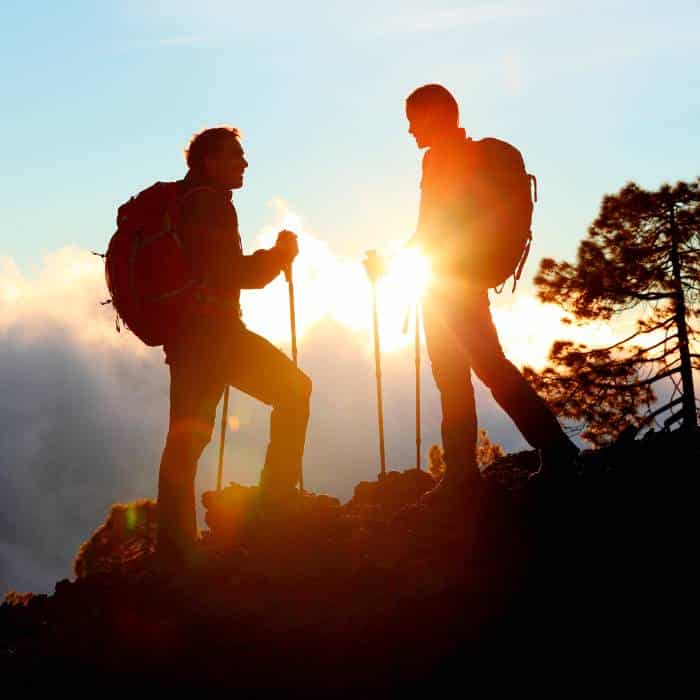
Hiking Glossary
If you’re new to hiking, you may feel overwhelmed by all the terminology and jargon experienced hikers use. Don’t worry—this handy hiking glossary will have you speaking the language of the trails in no time.
From switchbacks to scree, from blazes to bivouacs, the hiking world is full of specialized terms that can confuse beginners. This hiking glossary will decode those mysterious words and phrases. It will help you confidently navigate the trails and talk with your fellow hikers.
List of Hiking Terms
Here’s the hiking glossary list to effortlessly navigate the language of hikers:
| Term | Definition |
| Alpine Zone | A high-elevation area above the treeline characterized by fragile vegetation and rocky terrain. |
| AT | Stands for the Appalachian Trail, a long-distance hiking path on the East Coast of the United States. |
| Backpacking | Hiking and camping overnight in the backcountry with your gear carried in a backpack. |
| Base Layer | The layer of clothing directly next to your skin, often designed to manage moisture and maintain body temperature. |
| Bivouac | A temporary, tentless campsite, often improvised in the outdoors. |
| Bivy Sack | A small, waterproof sack that protects a sleeping bag, used as an alternative to a tent. |
| Blaze | A mark, usually painted on trees or posts, used to indicate the path of a trail. |
| Bear Bag | A bag that stores food and scented items hung from a tree to keep bears and other wildlife away from your campsite. |
| Bushwhacking | Hiking through dense forest, brush, or bushes where no trail exists. |
| Cairn | A man-made pile or stack of stones often used as trail markers. |
| Cache | A supply of food, water, or equipment left in a hidden or specified place for retrieval during a hike. |
| Cat Hole | A small, deep hole dug to dispose of human waste and toilet paper in the wilderness. |
| Contour Line | A line on a map connecting points of equal elevation, representing the shape and elevation of the land. |
| Crampons | Metal spikes that attach to boots for traction on ice and snow. |
| Gram Wennie | A hiker focused on reducing their pack weight, counting every gram. |
| Day Hike | A hike intended to be completed in a single day. |
| Deadman | An anchor made by burying an object in snow or sand, used to secure a tent in environments where stakes won’t hold. |
| Double-wall Tents | Tents that have two layers: an inner breathable layer and an outer waterproof layer, reducing condensation. |
| Elevation Gain | The total amount of vertical ascent over the course of a hike. |
| False Summit | A peak that appears to be the summit from below, but upon reaching it, another higher peak is revealed. |
| Fording | Crossing a river or stream without a bridge, usually by wading. |
| Gaiters | Protective coverings that wrap around the boot and lower leg to keep out rocks, dirt, water, and snow. |
| Headlamp | A light source worn on the head, allowing hands-free operation in the dark. |
| Hiker Box | A box found at trail stops where hikers can leave unwanted items for other hikers to use. |
| Hiker Hunger | The intense hunger experienced by hikers after days of burning calories on the trail. |
| Hiker Funk | The distinctive smell that develops after several days of hiking without access to showers. |
| Hot Spot | An area on the foot that is beginning to develop a blister. |
| Hiker Trash | A term of endearment for hikers who fully embrace the long-distance hiking lifestyle, often foregoing traditional hygiene. |
| Hydration Pack | A backpack equipped with a water reservoir and hose, allowing the wearer to drink hands-free. |
| Junction | A point where multiple hiking paths intersect, often marked for navigation. |
| Key Swap | A method where hikers start at opposite ends of a trail and exchange car keys when they meet. |
| Leave No Trace | A set of principles designed to promote outdoor conservation. |
| Loop Hike | A hike that starts and ends at the same location, following a looped trail. |
| Microspikes | Small, lightweight traction devices for shoes or boots to improve grip on ice and snow. |
| Notch | A low point or gap between peaks in a mountain range, often used for trails. |
| Out-and-Back Hike | A hike that follows the same path to the destination and back to the starting point. |
| Pace Count | The number of steps to cover a certain distance, used for navigation in wilderness areas. |
| PCT | Abbreviation for the Pacific Crest Trail, a long-distance trail from Mexico to Canada through California, Oregon, and Washington. |
| Peak Bagging | Climbing to the summit of a collection of peaks, often within a specific area or of a certain difficulty. |
| R-value | A rating indicating the insulation level of a sleeping pad; higher values mean better insulation from cold ground. |
| Scrambling | A method of ascending rocky faces and ridges using hands for balance and support, not as extreme as rock climbing. |
| Scree | Loose, broken stones on a mountain slope, tricky for hikers. |
| Switchback | A zigzag path on a steep incline designed to reduce the gradient of ascent. |
| Thru-Hiking | Hiking a long-distance trail from end to end within one hiking season. |
| Topo Map | A topographic map that details the terrain of an area, showing elevation through contour lines. |
| Trail Angel | A person who provides support, or “trail magic,” to hikers by offering assistance or supplies. |
| Trailhead | The point at which a trail begins. |
| Trekking Poles | Poles are designed to provide stability and support on rugged terrain. |
| Ultralight Backpacking | A style of backpacking that emphasizes carrying the lightest and simplest gear safely possible. |
| Ultralight Hikers | Hikers carrying minimal gear, often under 10 pounds, for efficiency and enjoyment on the trail. |
| Vitamin I | Slang for ibuprofen, used by hikers for pain relief. |
| Water Purification | The process of treating water from natural sources to make it safe to drink. |
| Yo-Yo | Hiking a trail end-to-end and then returning to the start point, doubling the journey. |
| Zero Day | A day spent not hiking during a multi-day hike, usually to rest or resupply. |


Takeaway
Having a comprehensive hiking glossary at your disposal can make all the difference when hitting the trails. Understanding the terminology used in hiking can enhance your overall experience and ensure a safe and enjoyable adventure.
So, whether you’re a beginner or a seasoned hiker, having a good grasp of hiking terminology from this glossary can help you navigate the trails with confidence and ease.
Happy hiking!

